D Link DWL8200APA1 802.11a/g Dual Band Access Point User Manual DWL8200AP MAN 042705 indd
D Link Corporation 802.11a/g Dual Band Access Point DWL8200AP MAN 042705 indd
D Link >
Contents
- 1. Users Manual 1 of 3
- 2. Users Manual 2 of 3
- 3. Users Manual 3 of 3
Users Manual 2 of 3
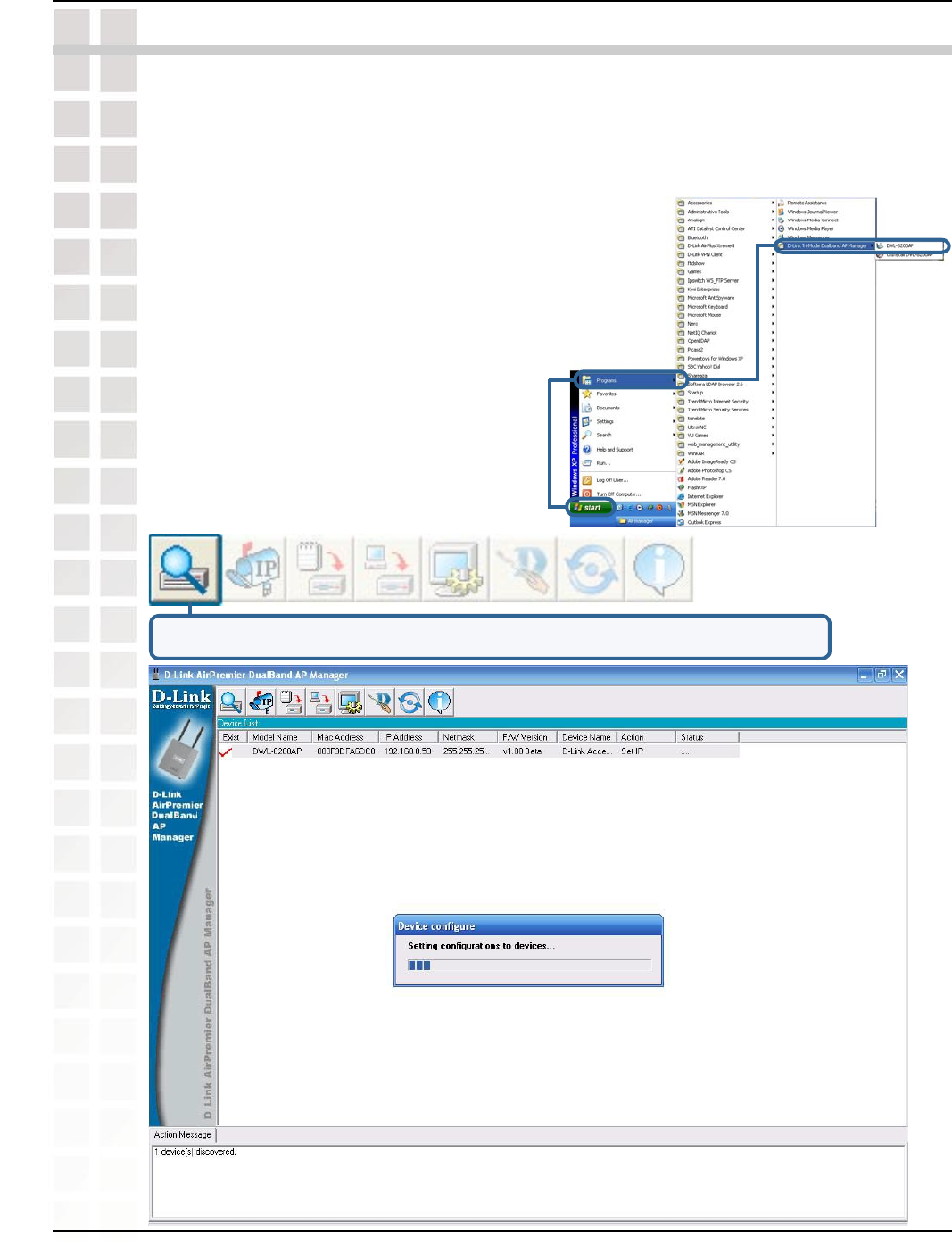
60
DWL-8200AP User’s Manual
D-Link Systems, Inc.
Using the AP Manager
The AP Manager is a convenient tool to manage the configuration of your network
from a central computer. With AP Manager there is no need to configure devices
individually.
To launch the AP Manager:
• Go to the Start Menu
• Select Programs
• Select D-Link TriMode Dualband AP Manager
• Select DWL-8200AP
Click on this button to discover the devices available on the network.
Discovering Devices
Using the AP Manager

61
DWL-8200AP User’s Manual
D-Link Systems, Inc.
Using the AP Manager
Selecting Devices
The AP Manager allows you to configure multiple devices all at once. To select a single
device, simply click on the device you want to select. To select multiple devices, hold
down the Ctrl key while clicking on each additional device. To select an entire list, hold
the Shift key, click on the first AP on the list and then click on the last AP on the list.
IP Configuration
You can assign an IP address to an AP or assign IP addresses to multiple
AP’s by clicking on this button after selecting the device(s).
Select the AP that you want to assign an IP address to and click the IP button. Enter
the IP address and IP netmask for the selected device and click OK.
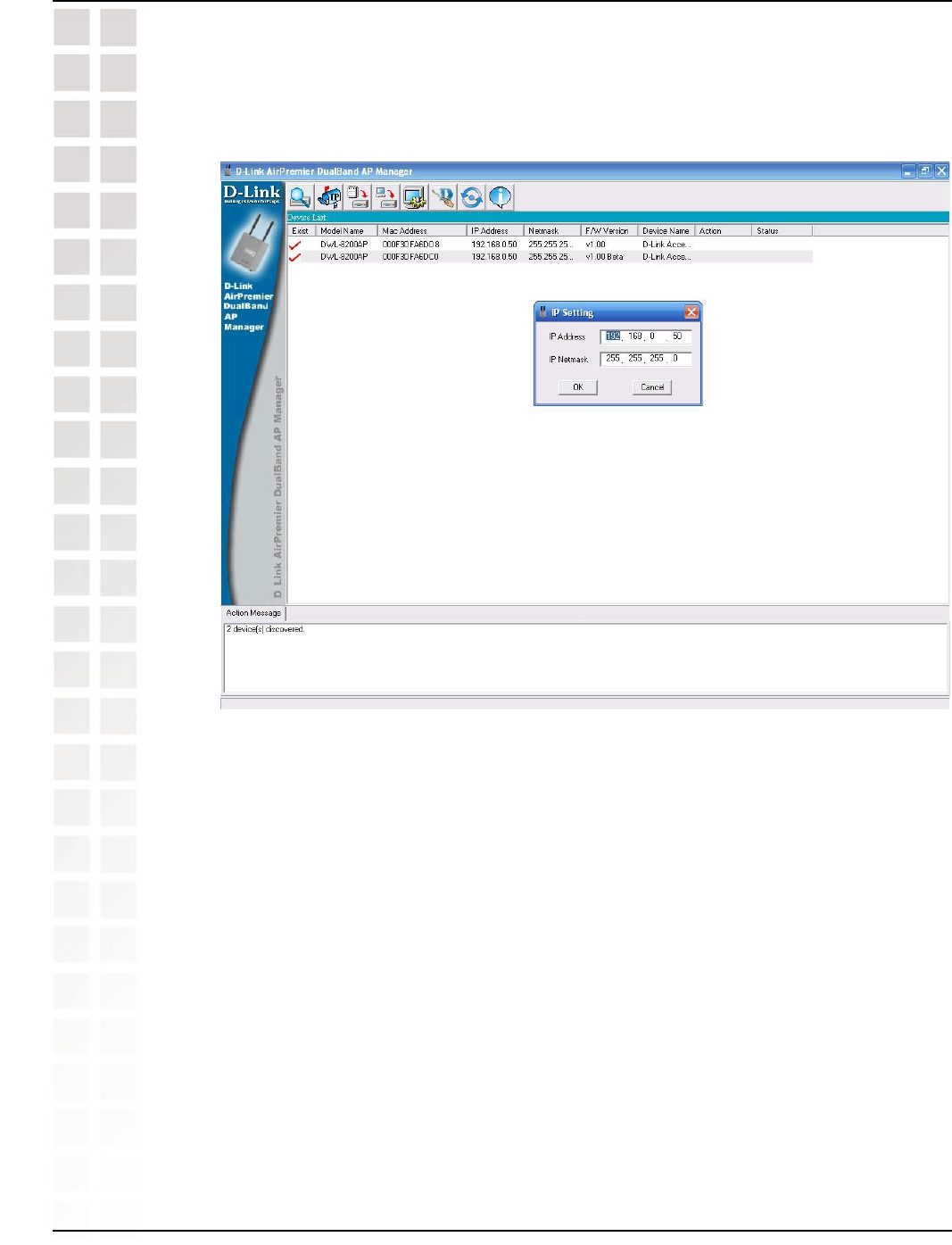
62
DWL-8200AP User’s Manual
D-Link Systems, Inc.
Using the AP Manager
IP Configuration (continued)
You can configure multiple AP’s with IP addresses all at once. Click on the IP button
after you’ve selected all of the AP’s you want to assign an IP address. Enter the IP
address you want to assign the first unit and the AP manager will automatically assign
sequential IP addresses.
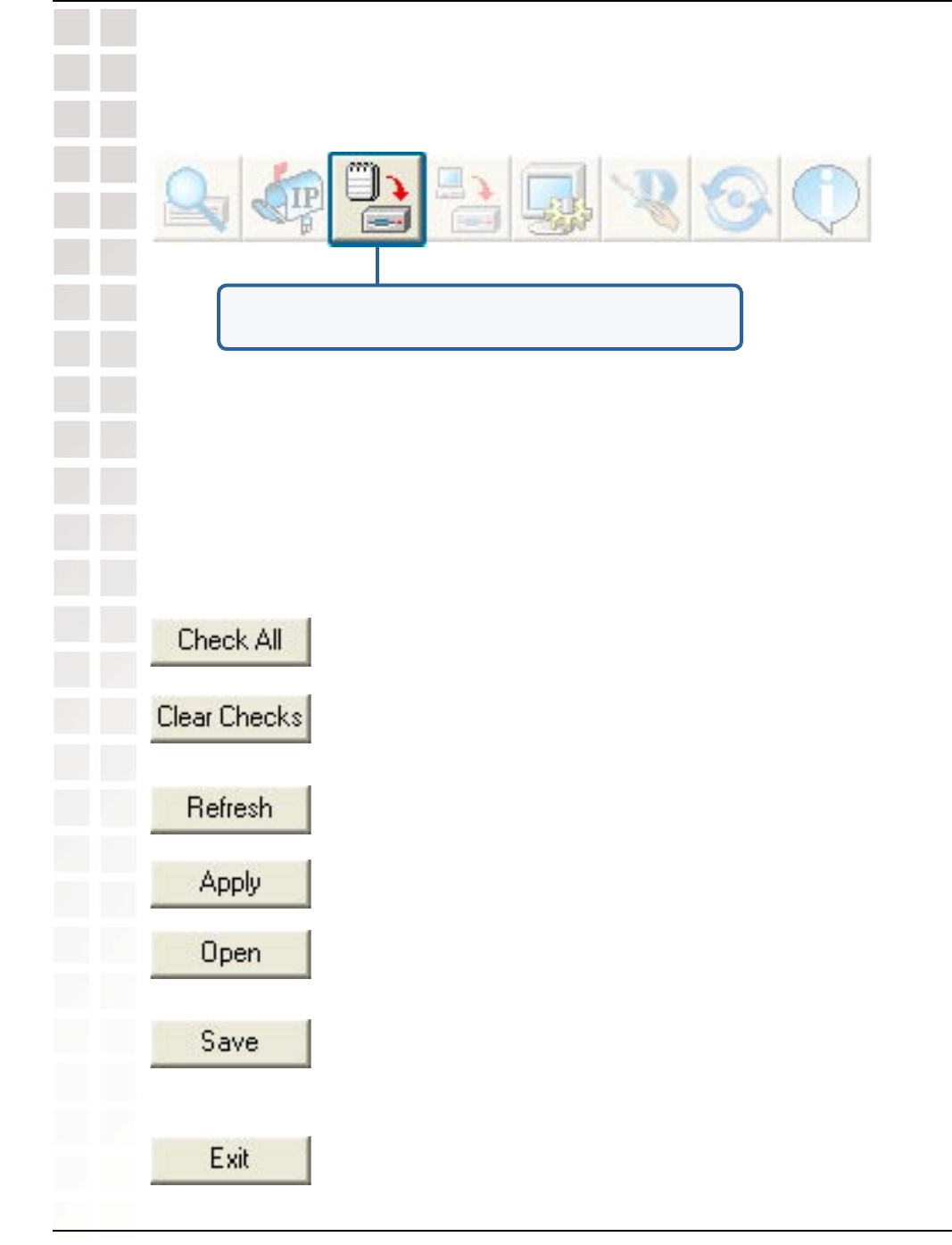
63
DWL-8200AP User’s Manual
D-Link Systems, Inc.
Using the AP Manager
Device Configuration
Click on this button to access the configuration
properties of the selected device(s).
The device configuration window allows you to configure settings but does not actually
apply the settings to the device unless you click the Apply button. You can also save
and load configuration files from this window. When you load a configuration file, you
must click Apply if you want the settings to be applied to the selected device(s).
The save button allows you to save a configuration file of the selected
device settings. Only settings that have a checkmark next to them
are saved. You cannot save a configuration file if you selected more
than one device in the device list.
The Exit button will close the device configuration window. Any
settings that haven’t been applied will be lost.
The open button is used to load a previously saved configuration file.
After opening a configuration file, you must click the Apply button to
save the settings to the selected device(s).
To save settings to the device, you must click the Apply button. Only
settings that have a checkmark next to them will be applied.
Refresh will revert to the actual device settings of the selected
device(s).
The Clear Checks button deselects all configurable options. This
feature is useful if you only want to change a few settings. Deselect
all items and only check the items that you want to modify.
The Check All button will select all configurable options. Any setting
that has a checkmark next to it is applied to the device or saved to
the configuration file.
You can configure a single device by highlighting one device in the list, or you can
configure multiple devices by highlighting multiple devices before clicking on the Device
Configuration icon pictured above. The examples in this section show single device
configuration. When you select multiple devices for configuration the procedure will be
similar.

64
DWL-8200AP User’s Manual
D-Link Systems, Inc.
Using the AP Manager
This allows you to change the device name for the selected
access point. You must place a checkmark in the Device Name
box to change the name. This option should only be configured
when one access point is selected for configuration.
If you’ve selected one device for configuration and you want
to change the IP address of the device, check the IP Address
box. You can then enter an IP address and Subnet Mask for the
selected access point. This option should only be configurable
when one access point is selected for configuration. To configure
multiple devices with an IP address at one time, please reference
the previous page.
Enter the IP address of your gateway, typically your router
address.
Device Configuration > General
Device Name(*):
IP address and
Subnet Mask(*):
Gateway:
When selecting multiple devices for configuration, some options are unavailable for
configuration by default as noted(*) below:

65
DWL-8200AP User’s Manual
D-Link Systems, Inc.
Using the AP Manager
Device Configuration > General (continued)
There is a pull-down menu to select enabled or disabled. When
enabled, the selected device(s) will function as a DHCP client(s).
This allows them to receive IP configuration information from a DHCP
server. When disabled, the access point(s) must have a static IP
address assigned to them.
This pull-down selection enables or disables load balancing. When
you enable load balance you allow several access points to balance
wireless network traffic and wireless clients among the access points
with the same SSID. All the APs that share Load Balancing must
have the same SSID. Assign each access point a different
non-overlapping channel (e.g., 1, 6, 11).
Enter the number of the limit of load balancing users, from 0-64.
From the pull-down selection, choose either Telnet or SSH for
Console protocol.
This pull-down selection defines the timeout period during a Telnet
session with the selected device(s).
Select Enable to set the SNMP setting.
DHCP client:
Load Balance:
User Limit:
Console Protocol:
Telnet Timeout:
Status:
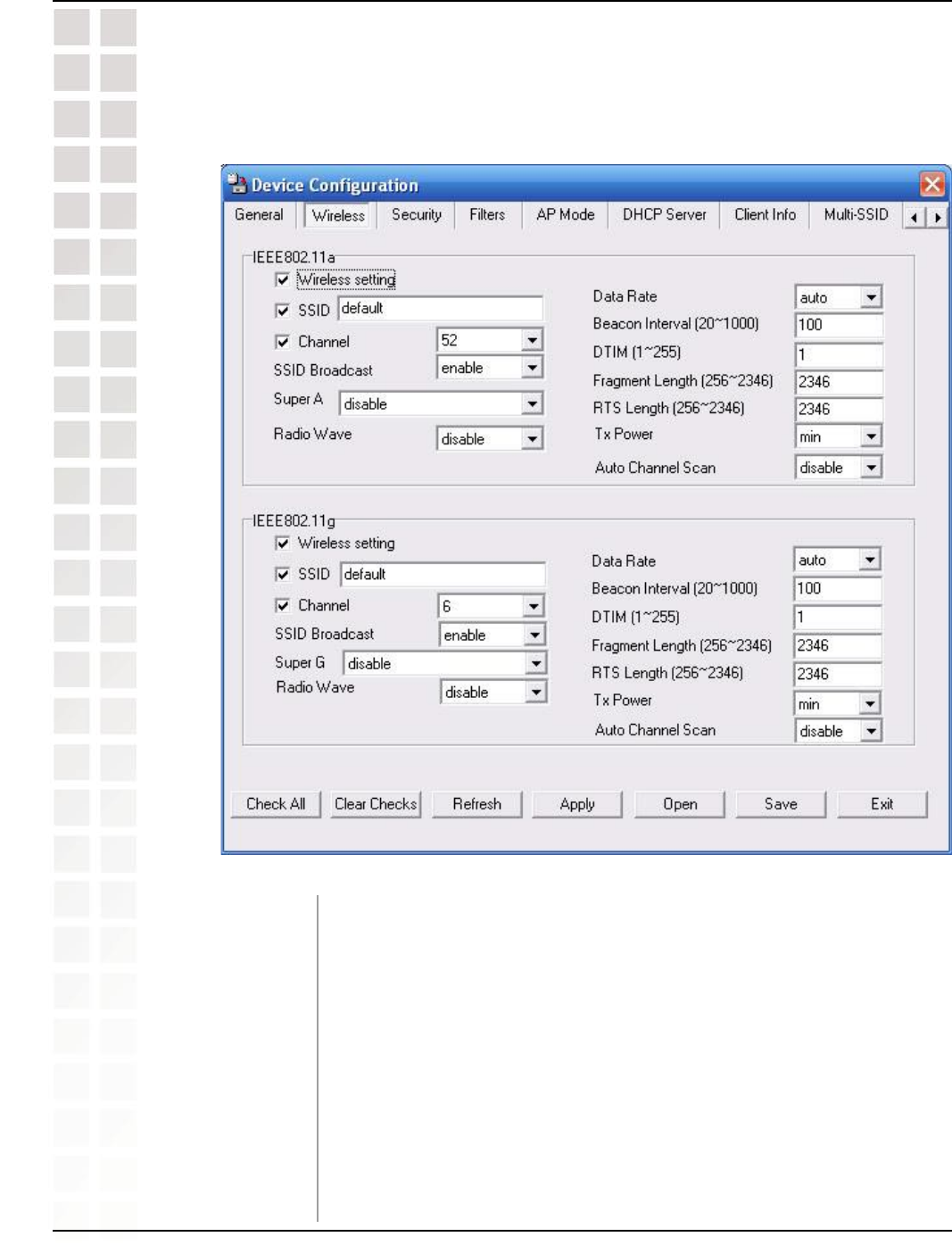
66
DWL-8200AP User’s Manual
D-Link Systems, Inc.
Using the AP Manager
Device Configuration > Wireless
Check to enable wireless mode.
The Service Set (network) Identifier of your wireless network.
Allows you to select a channel. 52 is the default setting for 802.11a
.
Allows you to enable or disable the broadcasting of the SSID to
network clients.
Select this option to enable a wireless signal rate of up to 108Mbps.
Super A is a group of performance enhancement features that
increase end user application throughput in an 802.11a network.
Super A is backwards compatible with standard 802.11a devices.
For ideal performance, all wireless devices on the network should
be Super A capable.
Wireless:
SSID:
Channel:
SSID Broadcast:
Super A:
IEEE 802.11a:
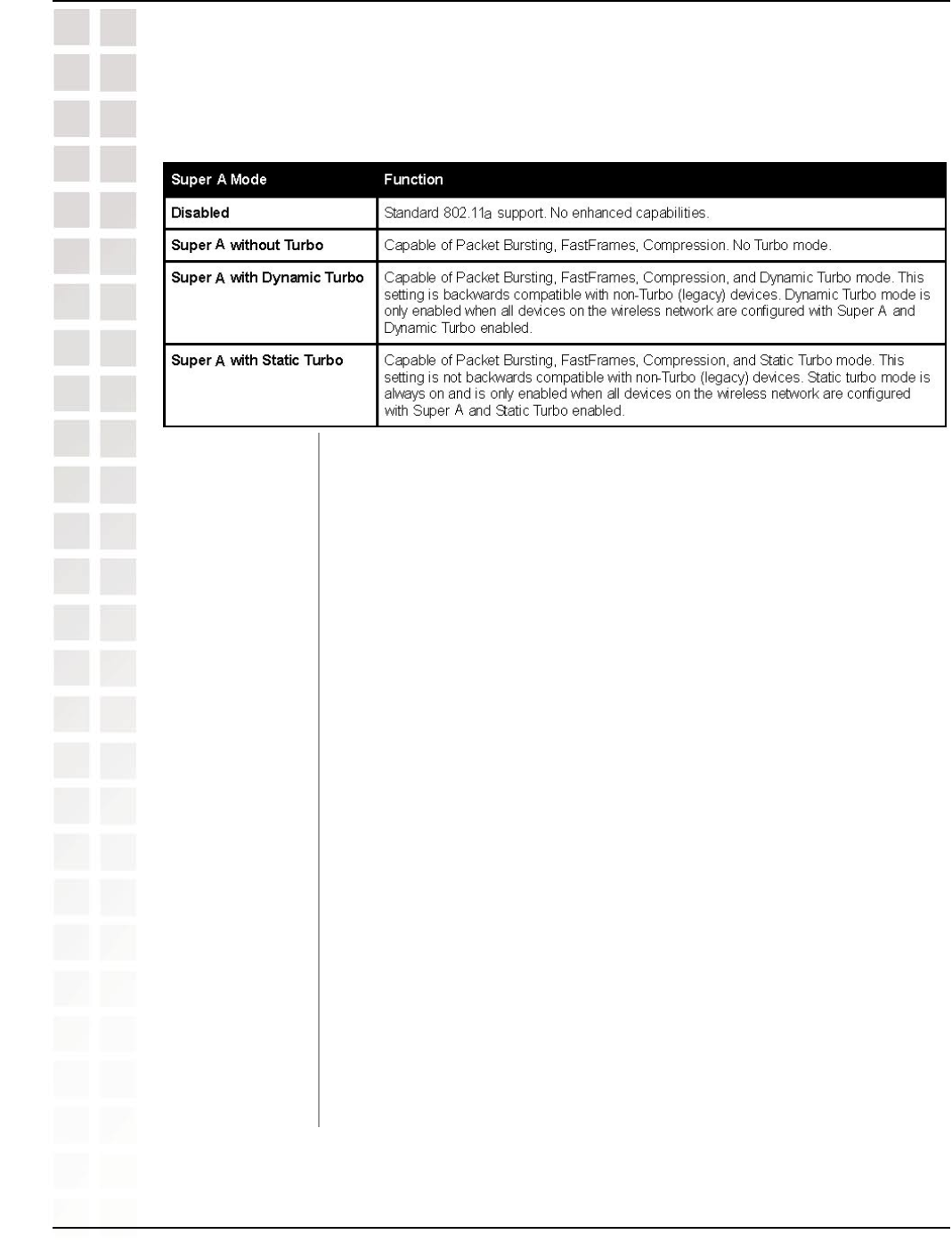
67
DWL-8200AP User’s Manual
D-Link Systems, Inc.
Using the AP Manager
Device Configuration > Wireless (continued)
*Maximum wireless signal rate derived from IEEE Standard 802.11a and 802.11g specifications. Actual
data throughput will vary. Network conditions and environmental factors, including volume of network
traffic, building materials and construction, and network overhead lower actual data throughput rate.
Select Enable or Disable.
A pull-down menu to select the maximum wireless signal rate for
the selected device(s).
Beacons are packets sent by an access point to synchronize a
network. Specify the beacon value for the selected device(s) here.
The default value of 100 is recommended.
DTIM (Delivery Traffic Indication Message) is a countdown informing
clients of the next listening window for broadcast and multicast
messages.
This sets the fragmentation threshold (specified in bytes). Packets
exceeding the value set here will be fragmented. The default is
2346.
The RTS value should not be changed unless you encounter
inconsistent data flow. The default value is 2346.
Choose full, half (-3dB), quarter (-6dB), eighth (-9dB), minimum
power. This tool can be helpful for security purposes if you wish to
limit the transmission range.
Enable this option to automatically select the most optimal channel
available for wireless networking and to scan for the least populated
channel.
Radio Wave:
Data Rate*:
Beacon Interval
(20~1000):
DTIM (1~255):
Fragment Length
(256~2346):
RTS Length
(256~2346):
Tx Power:
Auto Channel:

68
DWL-8200AP User’s Manual
D-Link Systems, Inc.
Using the AP Manager
Check to enable wireless mode.
The Service Set (network) Identifier of your wireless network.
Allows you to select a channel. 6 is the default setting.
Allows you to enable or disable the broadcasting of the SSID to
network clients.
Select this option to enable a wireless signal rate of up to
108Mbps.
Select Enable or Disable.
A pull-down menu to select the maximum wireless signal rate for
the selected device(s).
Beacons are packets sent by an access point to synchronize a
network. Specify the beacon value for the selected device(s) here.
The default value of 100 is recommended.
DTIM (Delivery Traffic Indication Message) is a countdown informing
clients of the next listening window for broadcast and multicast
messages.
This sets the fragmentation threshold (specified in bytes). Packets
exceeding the value set here will be fragmented. The default is
2346.
The RTS value should not be changed unless you encounter
inconsistent data flow. The default value is 2346.
Choose full, half (-3dB), quarter (-6dB), eighth (-9dB), minimum
power. This tool can be helpful for security purposes if you wish to
limit the transmission range.
Select this option to automatically select the most optimal channel
available for wireless networking.
Wireless:
SSID:
Channel:
SSID Broadcast:
Super G:
Radio Wave:
Data Rate*:
Beacon Interval
(20~1000):
DTIM (1~255):
Fragment Length
(256~2346):
RTS Length
(256~2346):
Tx Power:
Auto Channel:
IEEE 802.11g:
Device Configuration > Wireless (continued)
*Maximum wireless signal rate derived from IEEE Standard 802.11a and 802.11g specifications. Actual
data throughput will vary. Network conditions and environmental factors, including volume of network
traffic, building materials and construction, and network overhead lower actual data throughput rate.

69
DWL-8200AP User’s Manual
D-Link Systems, Inc.
Using the AP Manager
Device Configuration > Security > Authentication
Access Point
WDS with AP
WDS
Open
Shared
Both
WPA-Enterprise
WPA-Personal
WPA2-Enterprise
WPA2-Personal
WPA-Auto-Enterprise
WPA-Auto-Personal
Open
Shared
Both
WPA-Personal
WPA2-Personal
WPA-Auto-Personal
Open
Shared
Both
WPA-Personal
WPA2-Personal
WPA-Auto-Personal
AP Mode Authentication Available

70
DWL-8200AP User’s Manual
D-Link Systems, Inc.
Using the AP Manager
Device Configuration > Security > Authentication (continued)
The key is communicated across the network.
Limited to communication with devices that share the same WEP
settings.
The key is communicated and identical WEP settings are
required.
Select Open System/Shared Key to allow either form of data
encryption.
Select WPA-Enterprise to secure your network with the inclusion
of a RADIUS server.
Open:
Shared:
Both:
Authentication:

71
DWL-8200AP User’s Manual
D-Link Systems, Inc.
Using the AP Manager
Device Configuration > Security > Authentication (continued)
Select WPA-Personal to secure your network using a password
and dynamic key changes. (No RADIUS server required.)
Select WPA2-Enterprise to secure your network with the inclusion
of a RADIUS server and upgrade the encryption of data with the
Advanced Encryption Standard (AES).
Select WPA2-Personal to secure your network using a password
and dynamic key changes. No RADIUS server required and
encryption of data is upgraded with the Advanced Encryption
Standard (AES).
Select WPA-Auto-Enterprise to allow the client to either use
WPA-Enterprise or WPA2-Enterprise.
Select WPA-Auto-Enterprise to allow the client to either use
WPA-Personal or WPA2-Personal.
Authentication
(continued):

72
DWL-8200AP User’s Manual
D-Link Systems, Inc.
Using the AP Manager
Device Configuration > Security > Open/Shared/Both
The Security tab contains the WEP configuration settings on the initial page. If you select
WPA as the authentication type, an additional tab will appear with the WPA configuration
options based on your selection.
Authentication
Type:
Encryption:
Active Key Index:
Key Values:
Select from the pull-down menu the type of authentication to be used
on the selected device(s). In this example you may select Open,
Shared, or Both.
Enable or Disable encryption on the selected device(s). This option
will only be available when security is set to Open or Both.
Select which defined key is active on the selected device(s).
This
option will only be available when security is set to Open, Shared,
or Both.
Select the key size (64-bit, 128-bit, or 152-bit) and key type (HEX
or ASCII) and then enter a string to use as the key. The key length
is automatically adjusted based on the settings you choose. This
option will only be available when security is set to Open, Shared,
or Both.

73
DWL-8200AP User’s Manual
D-Link Systems, Inc.
Using the AP Manager
Device Configuration > Security > WPA-Enterprise, WPA2-Enterprise,
& WPA-Auto-Enterprise
Select Auto, TKIP, or AES from the pull-down menu.
Select the interval during which the group key will be valid. 1800 is the
recommended setting. A lower interval may reduce transfer rates.
Cipher Type:
Group Key Update
Interval:
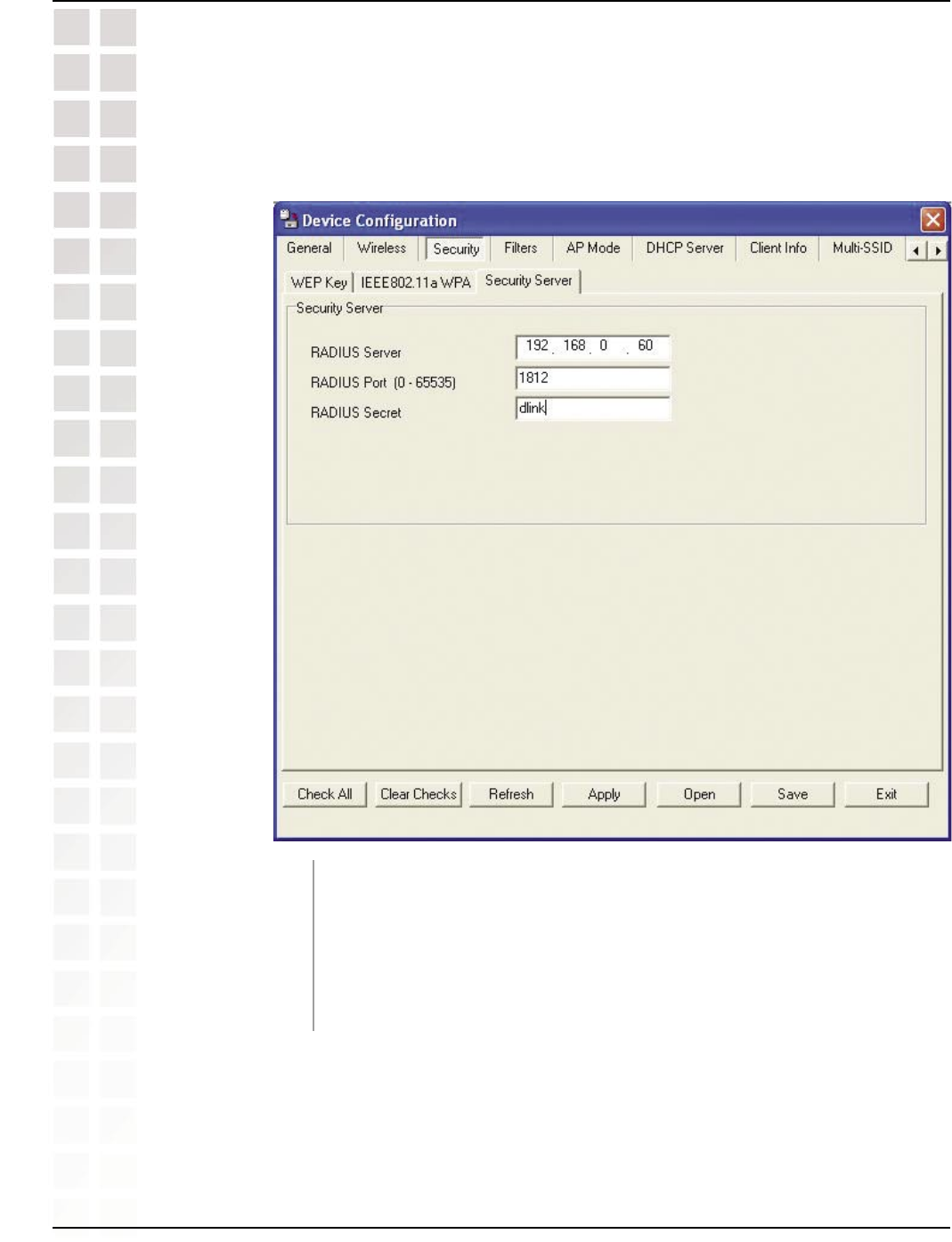
74
DWL-8200AP User’s Manual
D-Link Systems, Inc.
Using the AP Manager
Device Configuration > Security > WPA-Enterprise, WPA2-Enterprise,
& WPA-Auto-Enterprise > Security Server
Enter the IP address of the RADIUS server.
Enter the port used on the RADIUS server.
Enter the RADIUS secret.
RADIUS Server:
RADIUS Port:
RADIUS Secret:
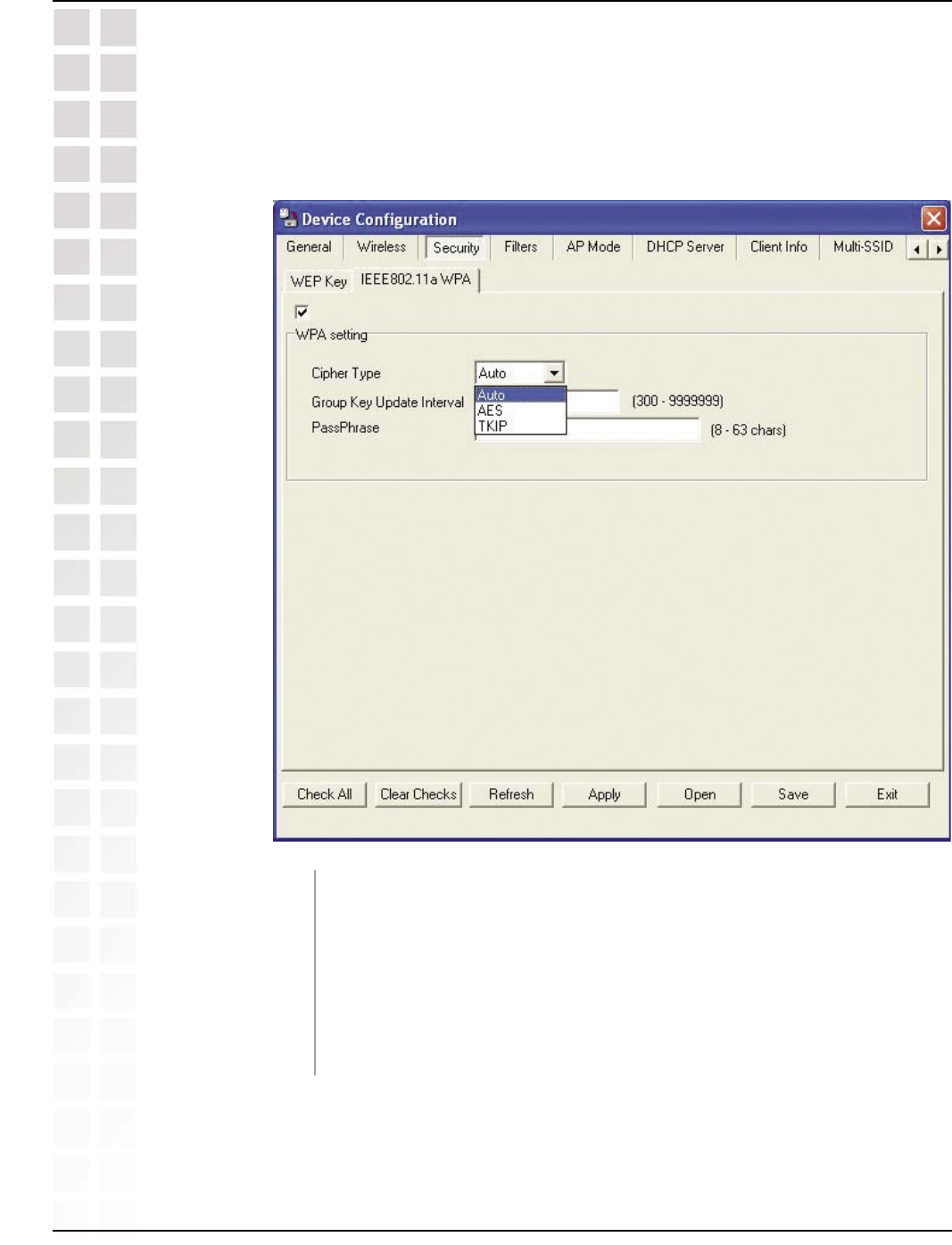
75
DWL-8200AP User’s Manual
D-Link Systems, Inc.
Using the AP Manager
Device Configuration > Security > WPA-Personal, WPA2-Personal,
& WPA-Auto-Personal
Select Auto, TKIP, or AES from the pull-down menu.
Select the interval during which the group key will be valid. 1800 is the
recommended setting. A lower interval may reduce transfer rates.
Enter a PassPhrase between 8-63 characters in length.
Cipher Type:
Group Key Update
Interval:
PassPhrase:
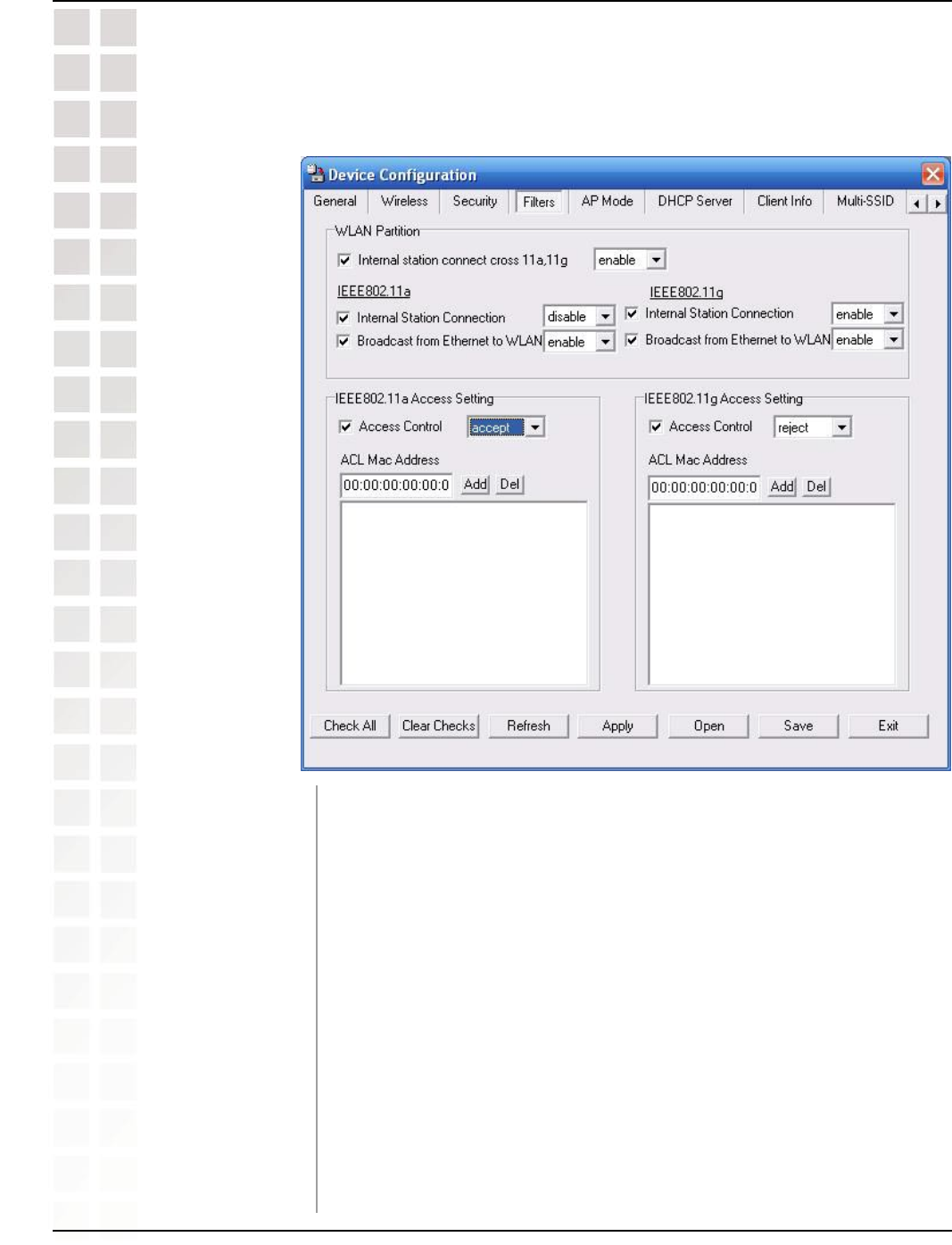
76
DWL-8200AP User’s Manual
D-Link Systems, Inc.
Using the AP Manager
Device Configuration > Filters
Enabling this allows wireless clients to communicate with each other.
When this option is disabled, wireless stations are not allowed to
exchange data through the access point.
Enabling this option allows Ethernet devices to communicate with
wireless clients. When this option is disabled, all data from Ethernet
to wireless clients is blocked. Wireless devices can still send data to
the Ethernet devices when this is disabled.
When disabled access control is not filtered based on the MAC
address. If Accept or Reject is selected, then a box appears for
entering MAC addresses. When Accept is selected, only devices
with a MAC address in the list are granted access. When Reject
is selected, devices in the list of MAC addresses are not granted
access.
Add or Delete MAC addresses in the Access Control List.
Internal Station
Connection:
Ethernet to WLAN
Access:
Access Control:
Access Control
List:
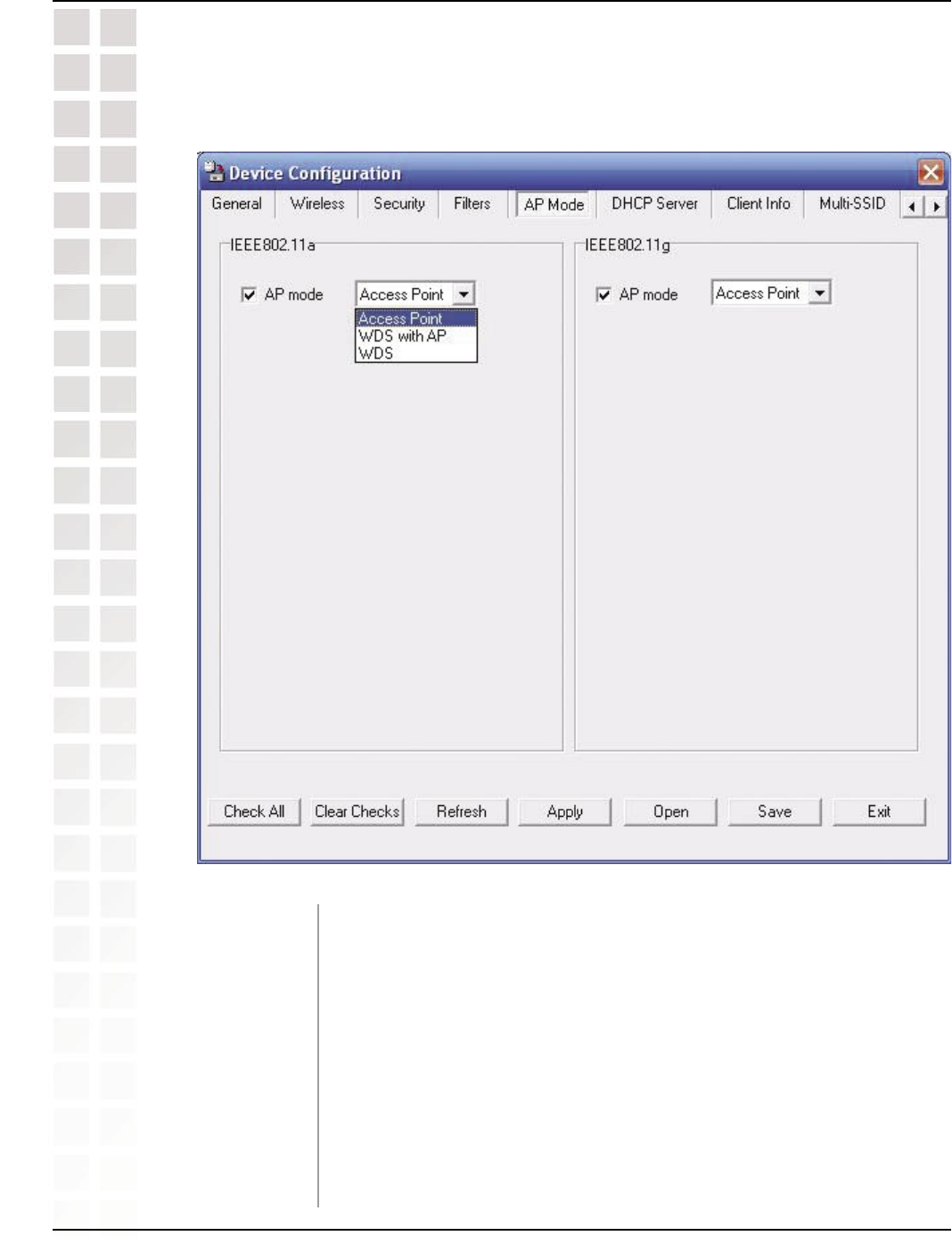
77
DWL-8200AP User’s Manual
D-Link Systems, Inc.
Using the AP Manager
Device Configuration > AP Mode
There are 3 AP modes:
Access Point
WDS with AP
WDS
Please see the following pages for an explanation of all the AP modes.
AP Mode:
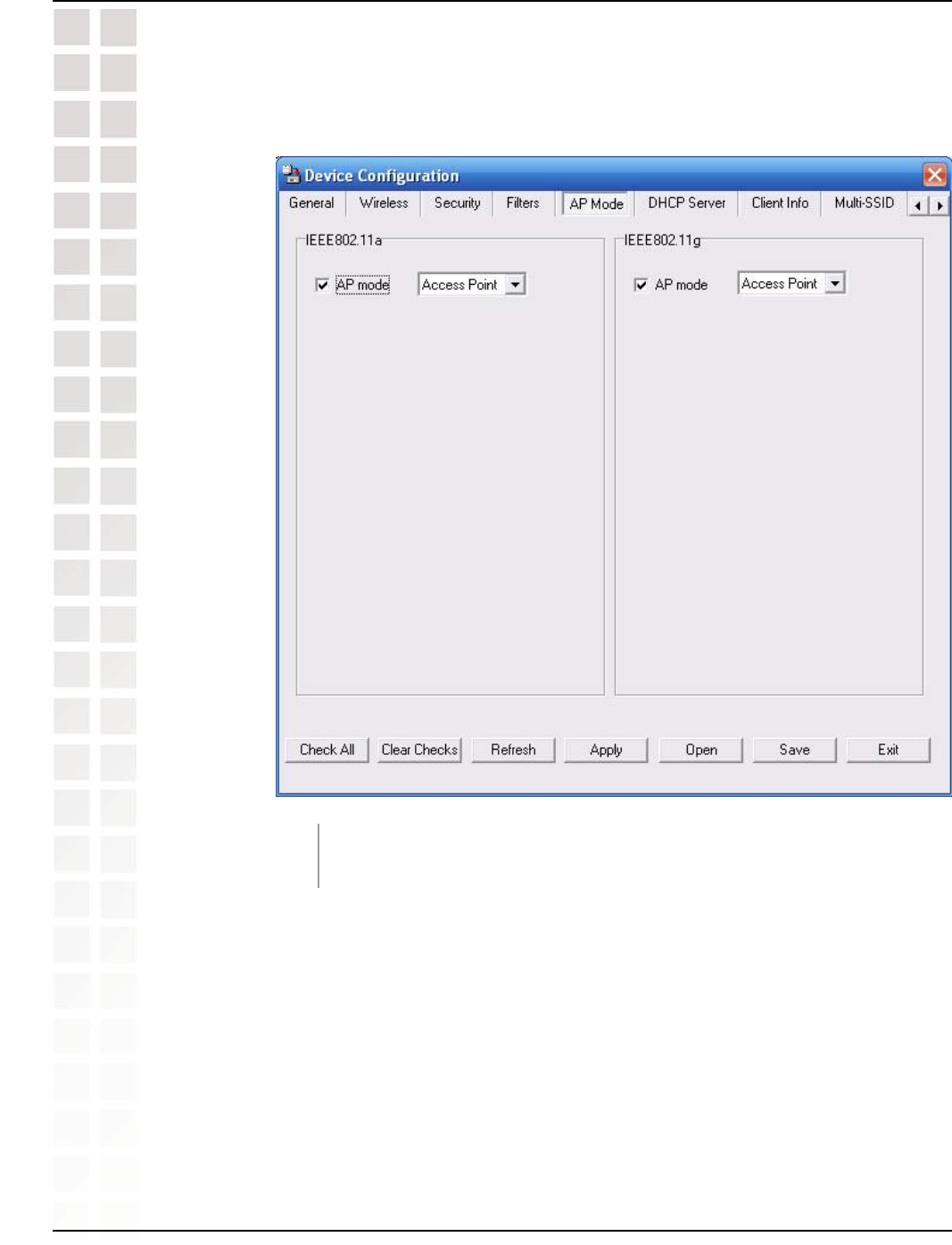
78
DWL-8200AP User’s Manual
D-Link Systems, Inc.
Using the AP Manager
Device Configuration > AP Mode > Access Point
Creates a Wireless LAN.
Access Point:

79
DWL-8200AP User’s Manual
D-Link Systems, Inc.
Using the AP Manager
Device Configuration > AP Mode > WDS with AP
Wireless Distribution System with Access Points. APs in a network
are wirelessly wired together and connected via a Distribution
System. The DWl-8200AP wirelessly connects multiple networks,
while still functioning as a wireless AP.
WDS with AP:
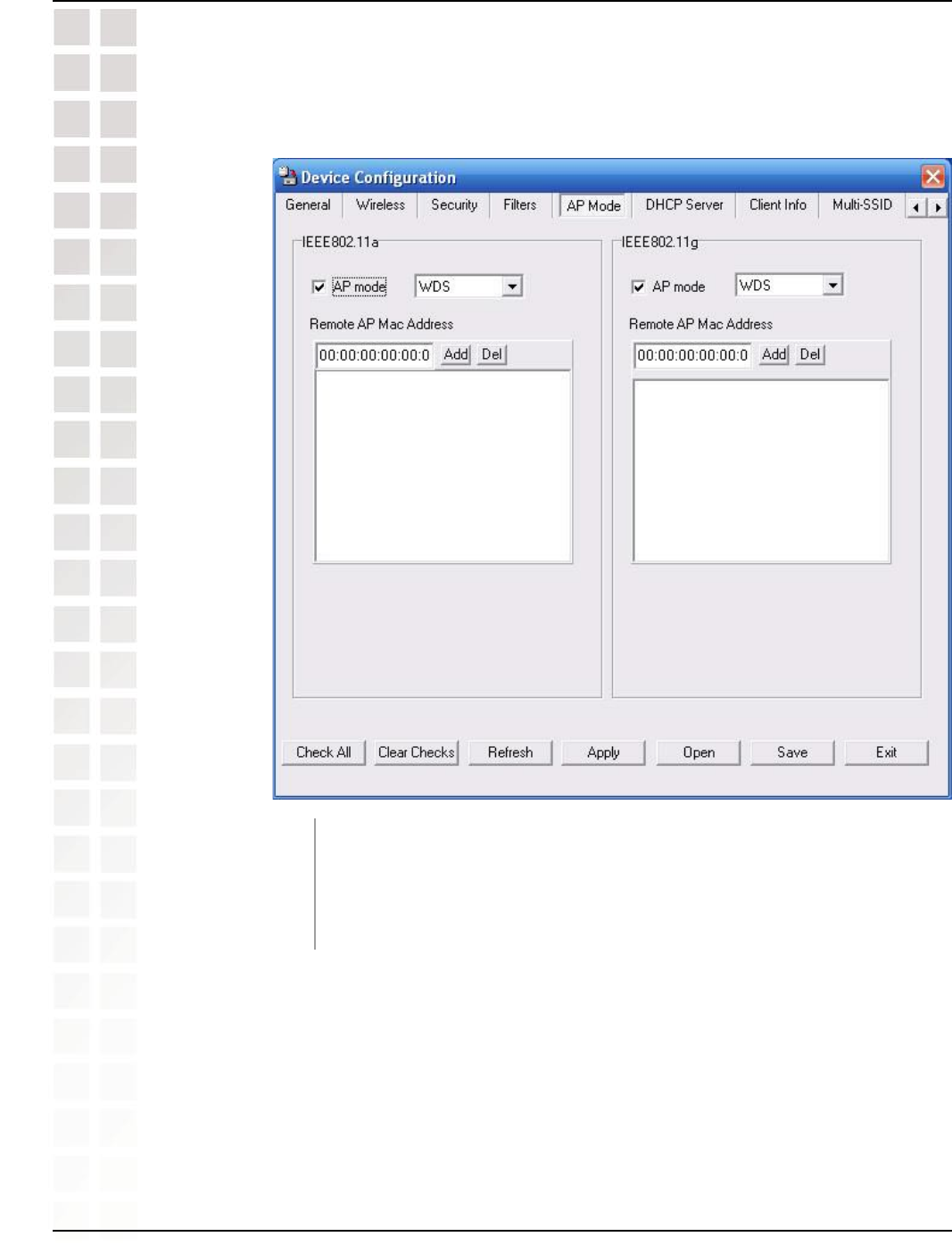
80
DWL-8200AP User’s Manual
D-Link Systems, Inc.
Using the AP Manager
Device Configuration > AP Mode > WDS
A Wireless Distribution System that interconnects so called Basic
Service Sets (BSS). It bridges two or more wired networks together
over wireless. The DWL-8200AP wirelessly connects multiple networks
without functioning as a wireless AP.
WDS:
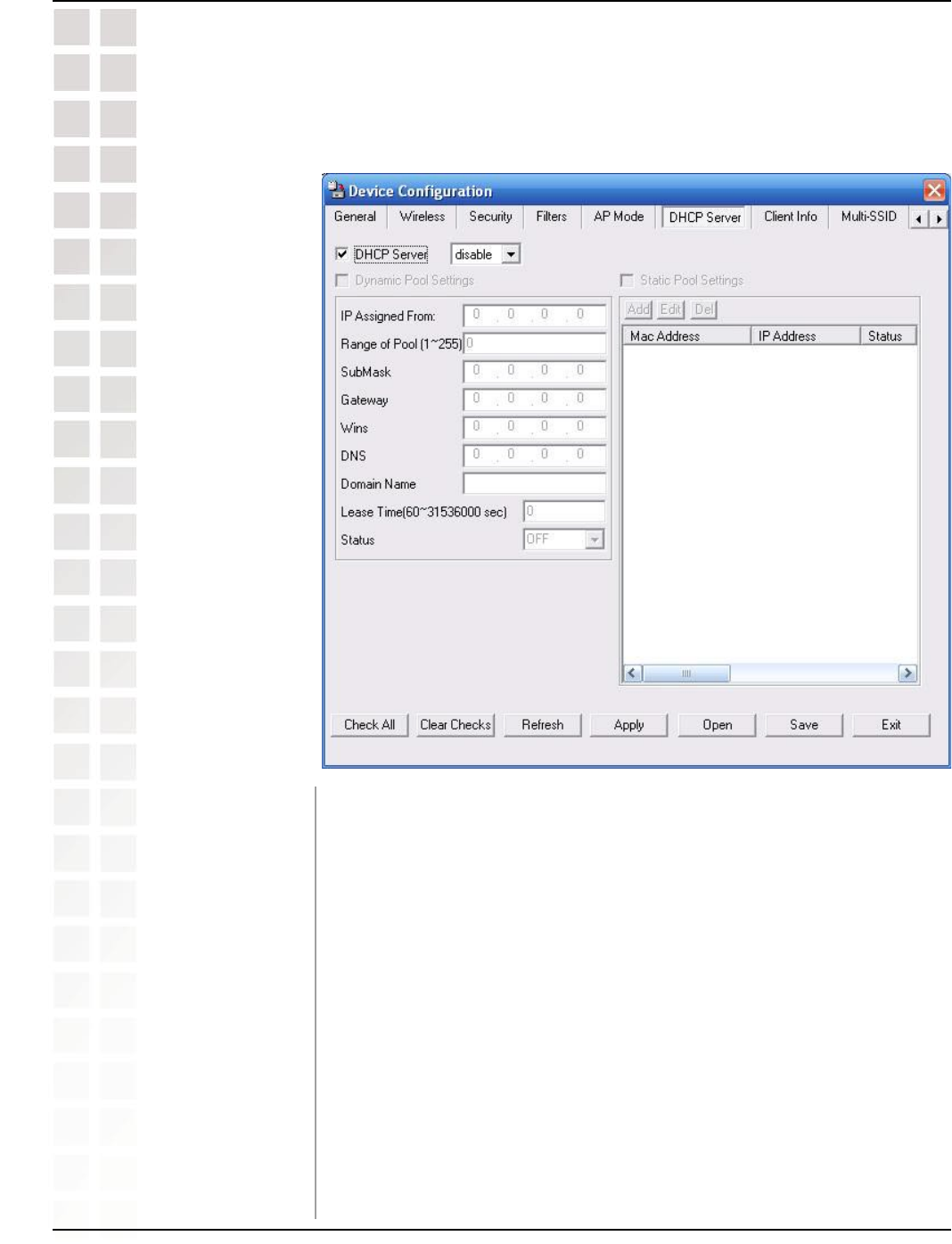
81
DWL-8200AP User’s Manual
D-Link Systems, Inc.
Using the AP Manager
Device Configuration > DHCP Server
Enable or disable the DHCP server function.
Click to enable Dynamic Pool Settings. Configure the IP address
pool in the fields below.
Click to enable Static Pool Settings. Use this function to assign the
same IP address to a device at every restart. The IP addresses
assigned in the Static Pool list must NOT be in the same IP range
as the Dynamic Pool.
Enter the initial IP address to be assigned by the DHCP server.
Enter the number of allocated IP addresses.
Enter the subnet mask.
Enter the gateway IP address, typically a router.
DHCP Server:
Dynamic Pool
Settings:
Static Pool
Settings:
IP Assigned From:
Range of Pool
(1~255):
SubMask:
Gateway:

82
DWL-8200AP User’s Manual
D-Link Systems, Inc.
Using the AP Manager
Device Configuration > DHCP Server (continued)
Wins (Windows Internet Naming Service) is a system that determines
the IP address of a network computer with a dynamically assigned
IP address, if applicable.
The IP address of the DNS server, if applicable.
Enter the domain name of the DWL-8200AP, if applicable.
The period of time that the client will retain the assigned IP
address.
This option turns the dynamic pool settings on or off.
Wins:
DNS:
Domain Name:
Lease Time:
Status:

83
DWL-8200AP User’s Manual
D-Link Systems, Inc.
Using the AP Manager
Device Configuration > Client Info
Displays the MAC address of the client.
Displays the wireless band.
Displays the type of authentication that is enabled.
Indicates the strength of the signal
Displays the status of the power saving feature.
Service Set Identifier (SSID) is the name designated for a specific
wireless local area network (WLAN). The SSID’s factory default
setting is default. The SSID can be easily changed to connect to an
existing wireless network or to establish a new wireless network.
MAC Address:
Band:
Authentication:
RSSI:
Power Mode:
SSID:
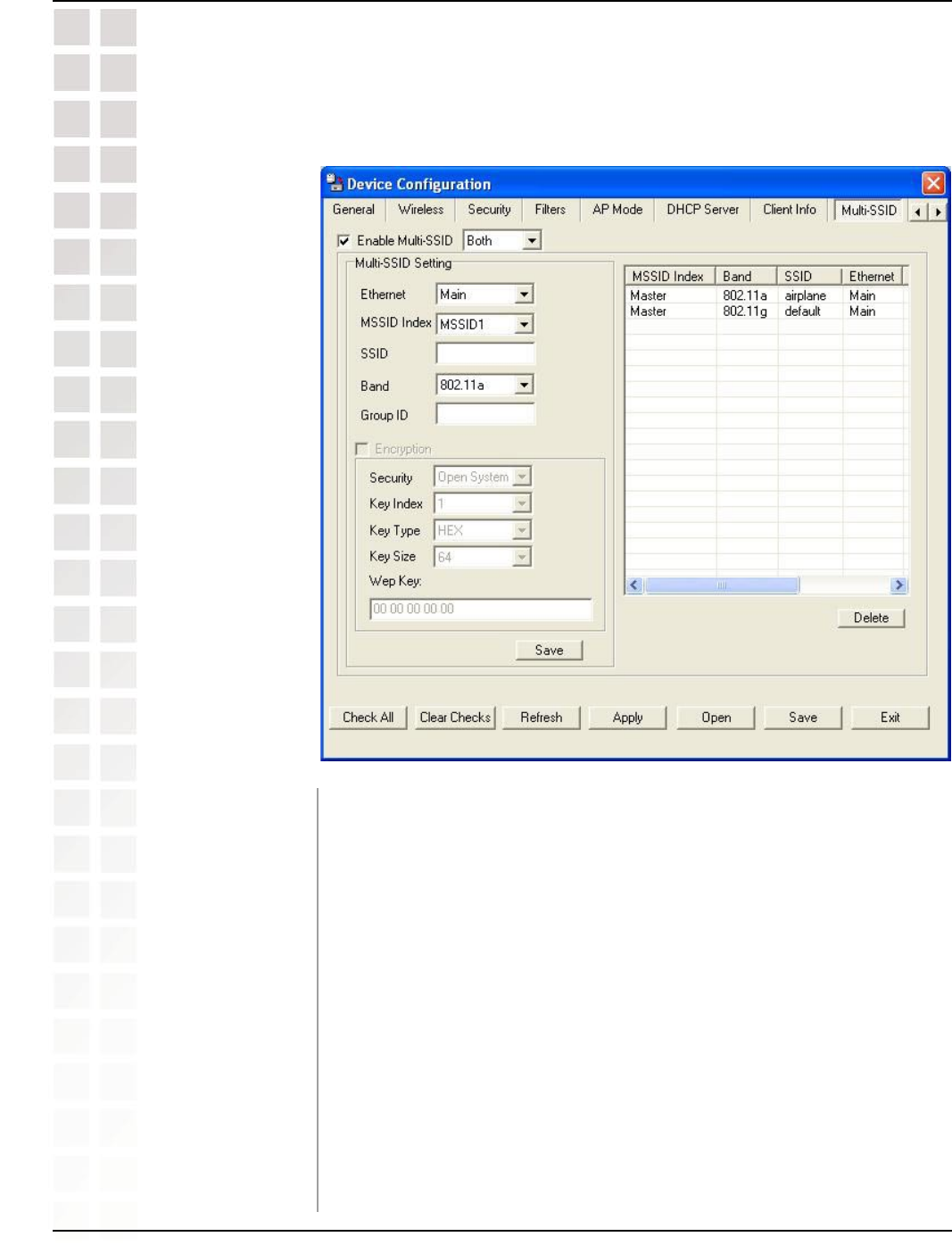
84
DWL-8200AP User’s Manual
D-Link Systems, Inc.
Using the AP Manager
Device Configuration > Multi-SSID
When Multi-SSID is enabled, you can configure your SSIDs for either
both, 11a only, or 11g only networks.
Select “Main” if you wish to configure the network on LAN 1 (PoE).
Select “Guest” to set up the network on LAN 2.
You can select up to 7 MSSIDs per band, the default MSSID is the
primary, which puts the total to 8 MSSIDs per band.
Service Set Identifier (SSID) is the name designated for a specific
wireless local area network (WLAN). The SSID’s factory default
setting is default. The SSID can be easily changed to connect to an
existing wireless network or to establish a new wireless network.
Select the wireless band (IEEE802.11a or IEEE802.11g).
Enable Multi-SSID:
Ethernet:
MSSID Index:
SSID:
Band:

85
DWL-8200AP User’s Manual
D-Link Systems, Inc.
Using the AP Manager
Device Configuration > Multi-SSID (continued)
You can assign a value to group all of the SSIDs to each other. The
Group ID is 0 by default, which is also considered Primary SSID. Use
Group ID 0-15 for “Main”, or use Group ID 16-30 for “Guest”.
Enable or Disable encryption on the selected device(s).
Select either None, Open System, or Shared Key.
Select which defined key is active on the selected device(s).
Select HEX or ASCII.
Select 64-bit, 128-bit, or 152-bit.
Enter a string to use as the key.
Group ID:
Encryption:
Security:
Key Index:
Key Type:
Key Size:
WEP key:

86
DWL-8200AP User’s Manual
D-Link Systems, Inc.
Using the AP Manager
Device Configuration > Rogue AP
Select the Security type Off, WEP, WPA-Enterprise, and
WPA-Personal that you would like to be consider during AP
detection.
This window shows all of the neighbor APs detected, which is
based on your criteria from above (BSS Type, Band, and Security).
If the AP is in the same network, or if you know the AP, just click
on “Add” to save it to the AP list.
This window shows all of the APs that are allowed access on
the network.
Security:
Rogue AP List:
AP List:
The Basic Service Set Type allows you to select from AP BSS, Ad
Hoc, or Both.
Select the type of network (bands 11a, 11b, and 11g) that you would
like the AP detection to search on.
BSS Type:
Band:
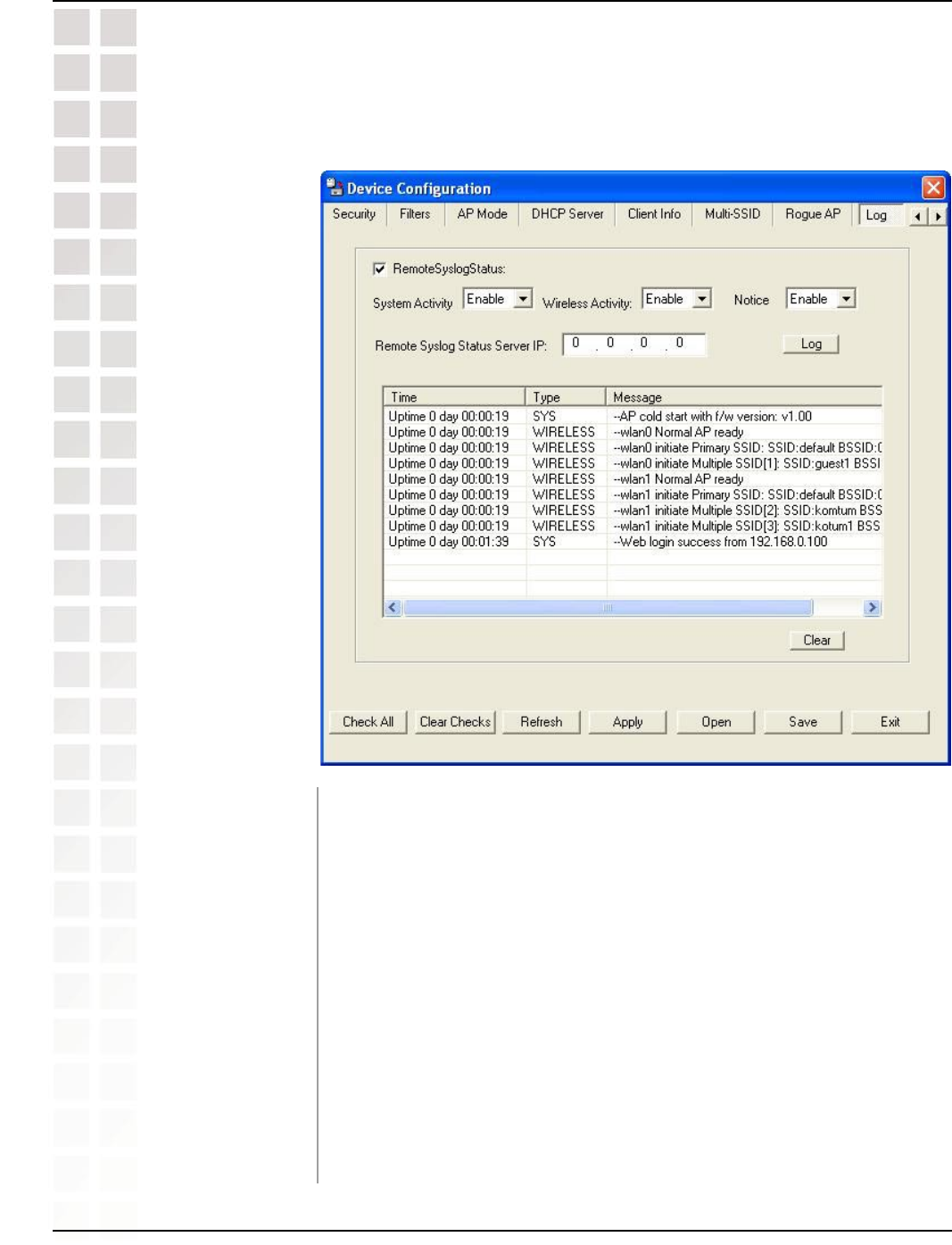
87
DWL-8200AP User’s Manual
D-Link Systems, Inc.
Using the AP Manager
Device Configuration > Log
Check this option to enable the log and the Remote Syslog Status
Server IP.
Select Enable to allow the logging of system actions, such as logging
a firmware upgrade.
Select Enable to allow the logging of any wireless clients that connect
to the AP.
Select Enable to allow all other information to be logged.
If you require more space to hold your logs, please provide the
IP address of the Server that will store your logs. The embedded
memory can only have up to 500 logs.
RemoteSyslogStatus:
System Activity:
Wireless Activity:
Notice:
Remote Syslog
Status Server IP:
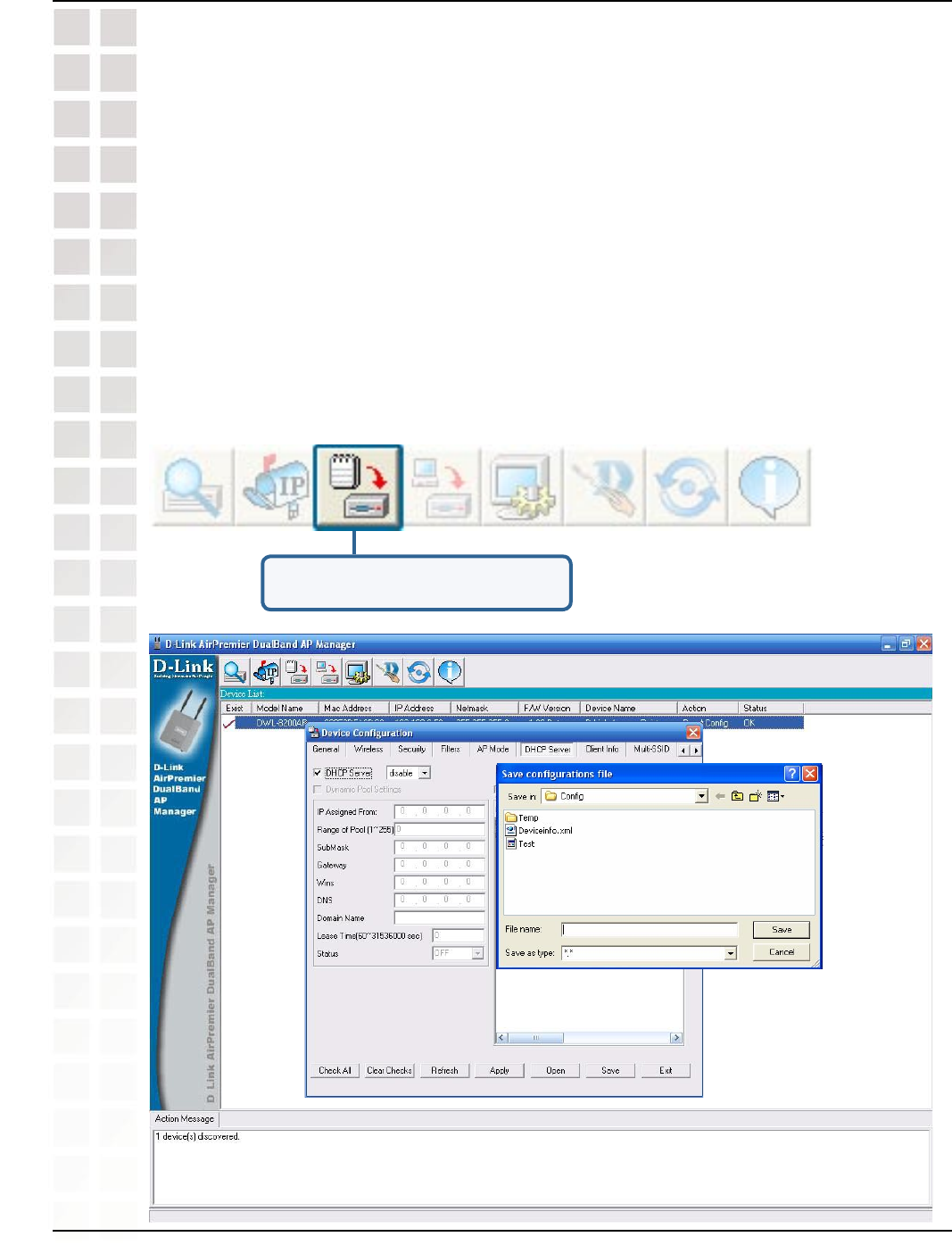
88
DWL-8200AP User’s Manual
D-Link Systems, Inc.
Using the AP Manager
Configuration Files
The DWL-8200AP allows you to save the device settings to a configuration file. To save
a configuration file follow these steps:
Select a device from the Device List on the main screen of the AP Manager.
Click the device configuration button.
Click the Save button after you have all the settings as you want them.
A popup window will appear prompting you for a file name and location. Enter the
file name, choose a file destination, and click Save.
Device Configuration button.
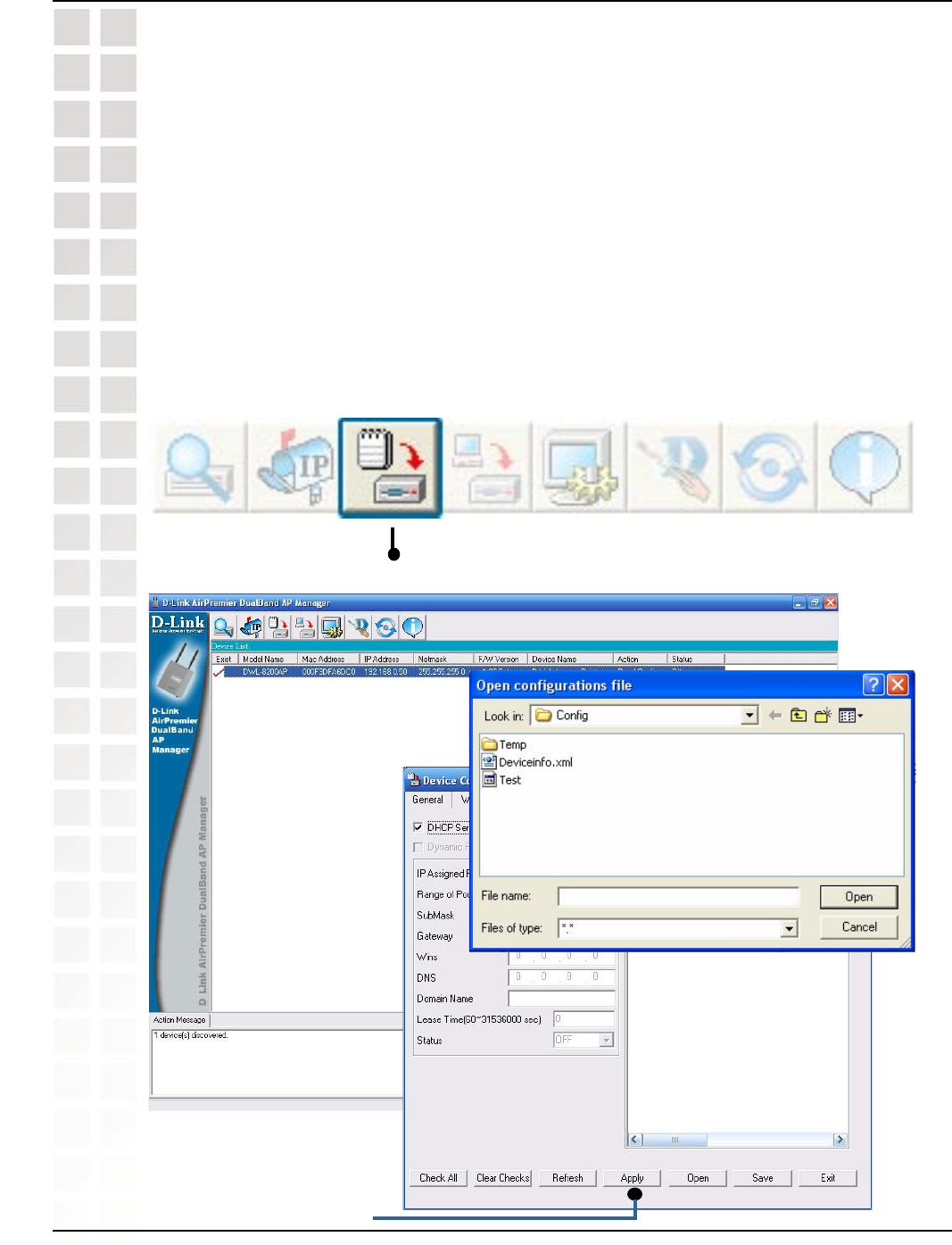
89
DWL-8200AP User’s Manual
D-Link Systems, Inc.
Using the AP Manager
You must always click Apply
in the Configuration window if
you want the settings to take
effect.
To load a previously saved configuration file, follow these steps:
Select a device from the Device List on the main screen of the AP Manager.
Click the device configuration button.
Click the Open button.
A popup window will appear prompting you to locate the configuration file. Locate
the file and click Open.
The configuration file is loaded into the AP Manager but has not actually been
written to the device(s). If you want to use the newly loaded configuration for the
selected device(s), click Apply and the configuration settings will be written to the
device(s).
Device Configuration button.

90
DWL-8200AP User’s Manual
D-Link Systems, Inc.
Using the AP Manager
To upgrade the firmware:
Download the latest firmware upgrade from http://support.dlink.com to an easy to
find location on your hard drive.
Click on the firmware button as shown above.
A popup window will appear. Locate the firmware upgrade file and click Open.
You can upgrade the firmware by clicking on this button after selecting the device(s).
Firmware
IMPORTANT! DO NOT DISCONNECT POWER FROM THE UNIT WHILE THE
FIRMWARE IS BEING UPGRADED.
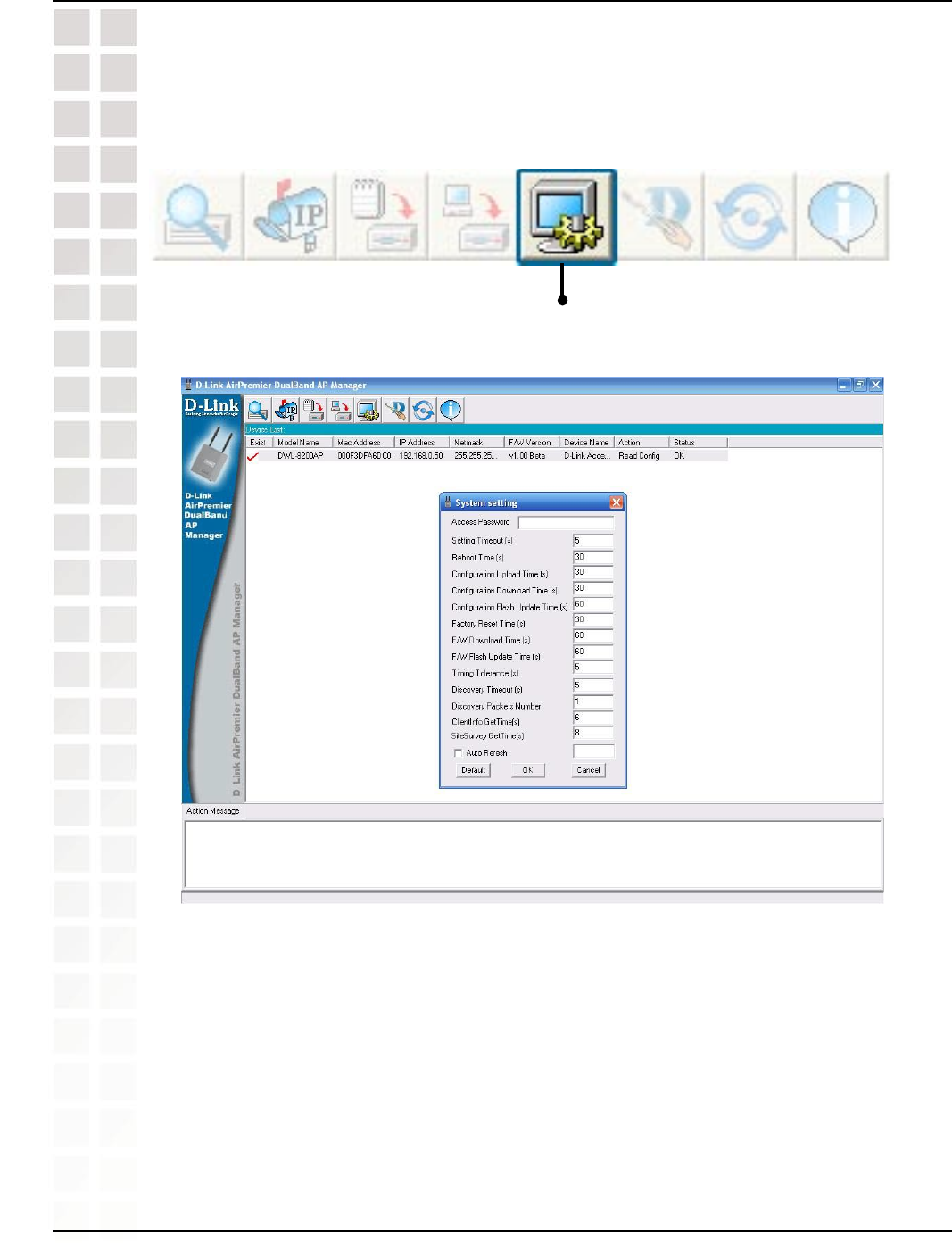
91
DWL-8200AP User’s Manual
D-Link Systems, Inc.
Using the AP Manager
You can customize the basic System Settings for the
DWL-8200AP by clicking on this button.
System Settings
Access Password: This sets the admin password for the selected device(s).
Auto Refresh: This setting allows you to enable auto refreshing of the network
device list. By default this option is disabled. If you choose to enable it, you must
enter the refresh interval in seconds.
All other settings on this screen should be left at the default setting.

92
DWL-8200AP User’s Manual
D-Link Systems, Inc.
Using the AP Manager
Setup Wizard
This button will launch the Setup Wizard that will guide
you through device configuration.
Click Next.
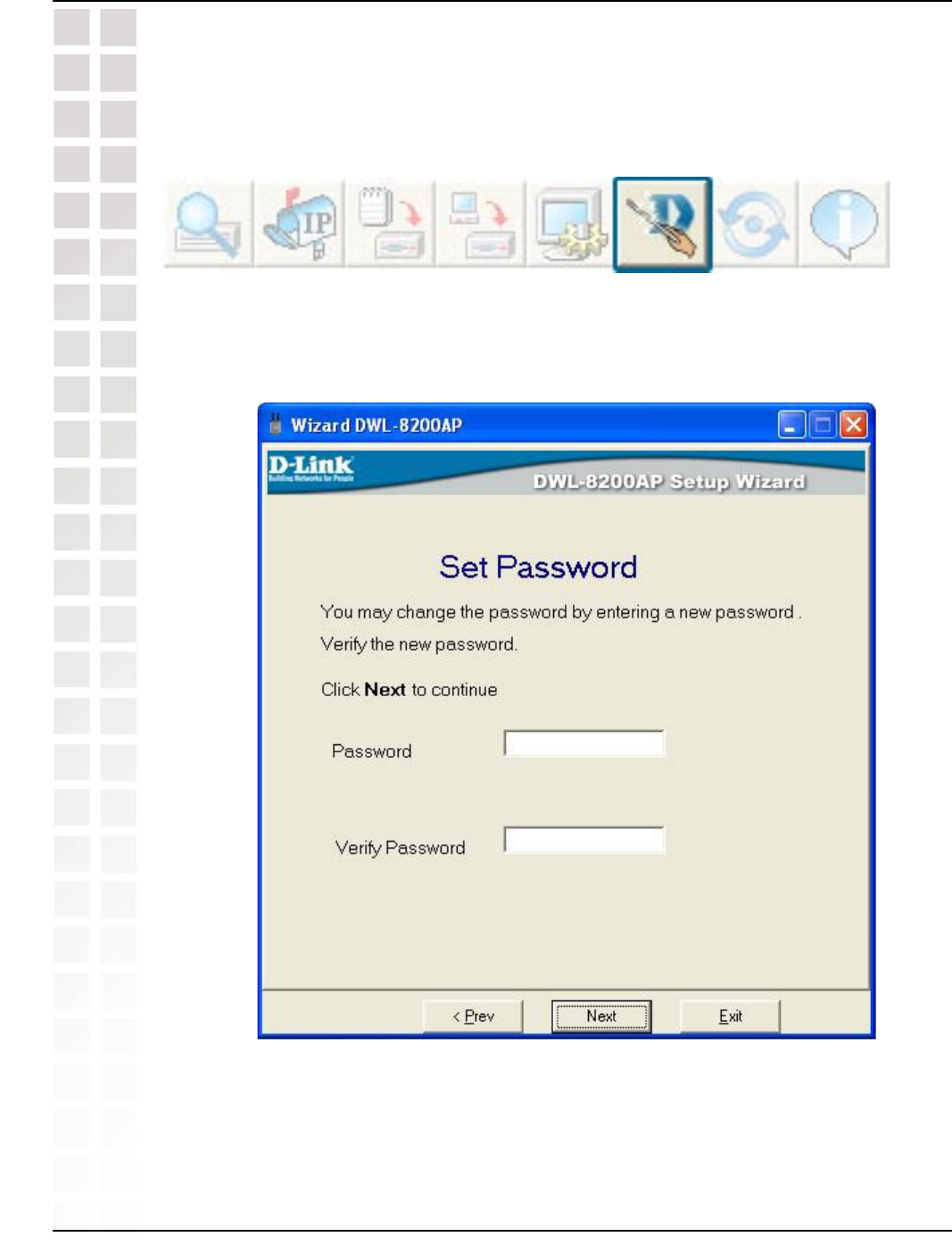
93
DWL-8200AP User’s Manual
D-Link Systems, Inc.
Using the AP Manager
Setup Wizard (continued)
Enter a Password and retype it in the Verify Password field.
Click Next.
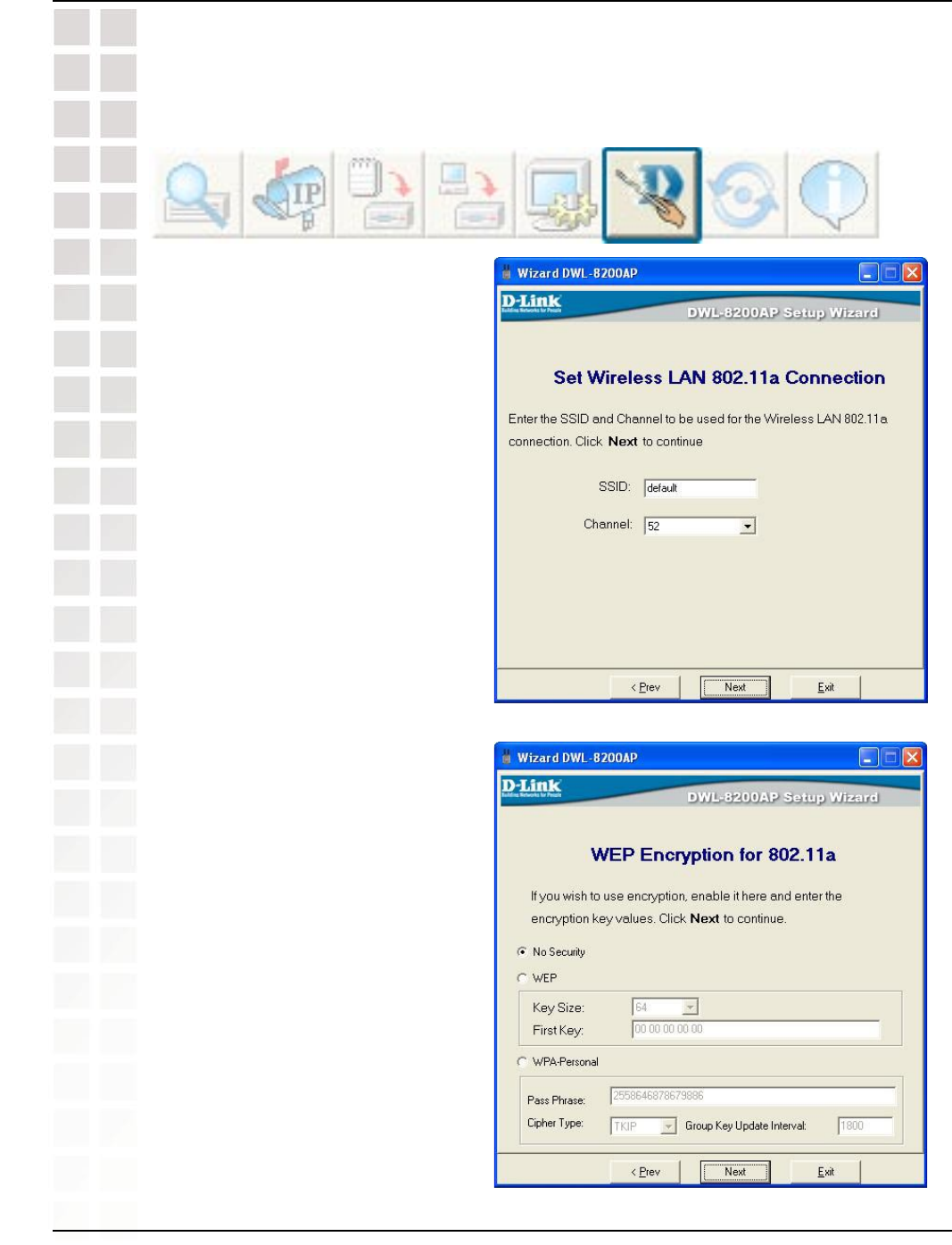
94
DWL-8200AP User’s Manual
D-Link Systems, Inc.
Using the AP Manager
Setup Wizard (continued)
Enter the SSID and the
Channel for the IEEE
802.11a network.
Click Next.
Select No Security, if you
do not require a method of
encryption.
Click Next.

95
DWL-8200AP User’s Manual
D-Link Systems, Inc.
Using the AP Manager
Setup Wizard (continued)
Click Next.
Select WPA-Personal, as
your method of encryption.
A Pass Phrase, and Group
Key Update Interval are
required.
Click Next.
Select WEP, as your method
of encryption. A Key Size
and First Key value are
required.

96
DWL-8200AP User’s Manual
D-Link Systems, Inc.
Using the AP Manager
Setup Wizard (continued)
Enter the SSID and the
Channel for the IEEE
802.11g network.
Click Next.
Select No Security, if you
do not require a method of
encryption.
Click Next.
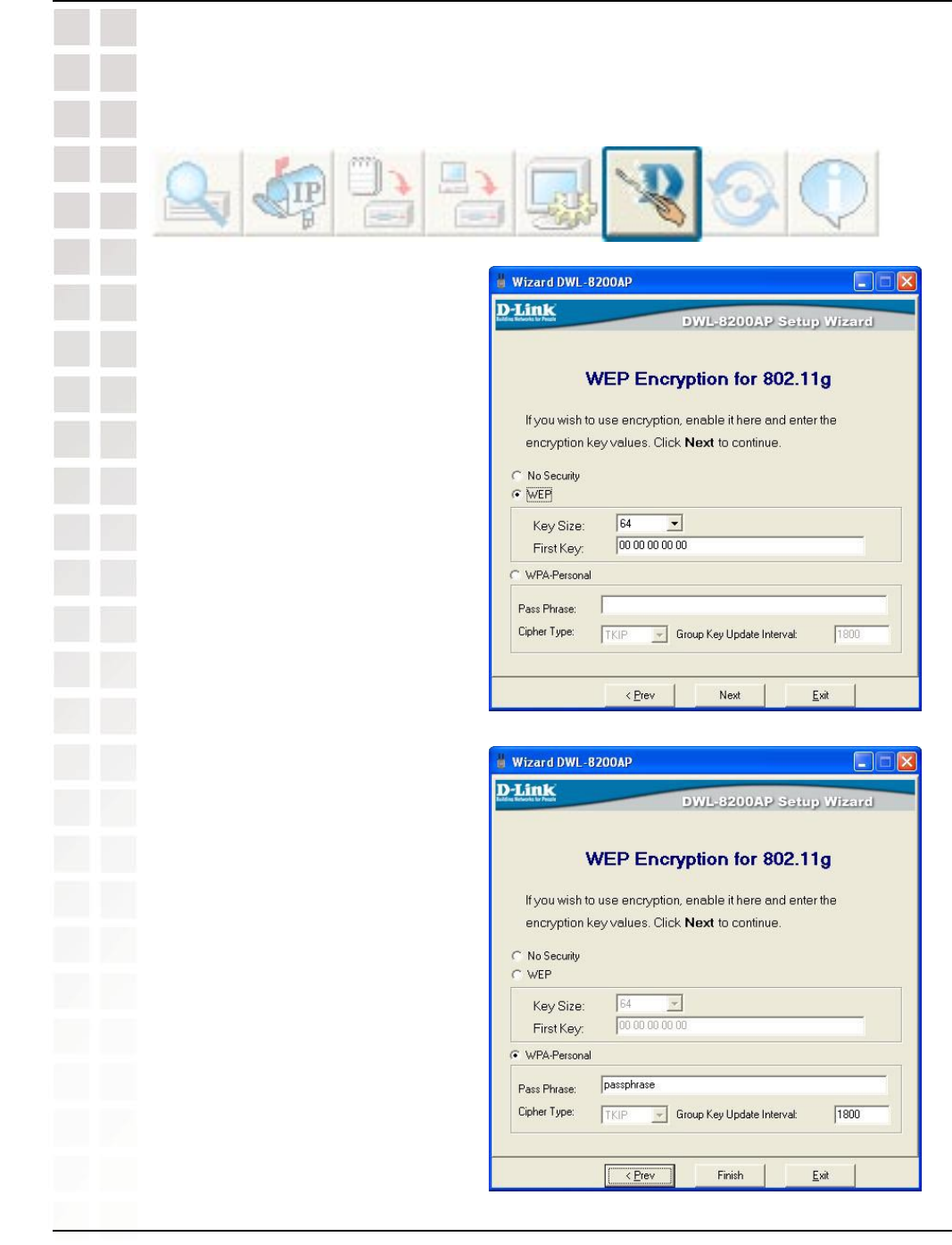
97
DWL-8200AP User’s Manual
D-Link Systems, Inc.
Using the AP Manager
Setup Wizard (continued)
Select WEP, as your method
of encryption. A Key Size
and First Key value are
required.
Click Next.
Select WPA-Personal, as
your method of encryption.
A Pass Phrase, and Group
Key Update Interval are
required.
Click Next.
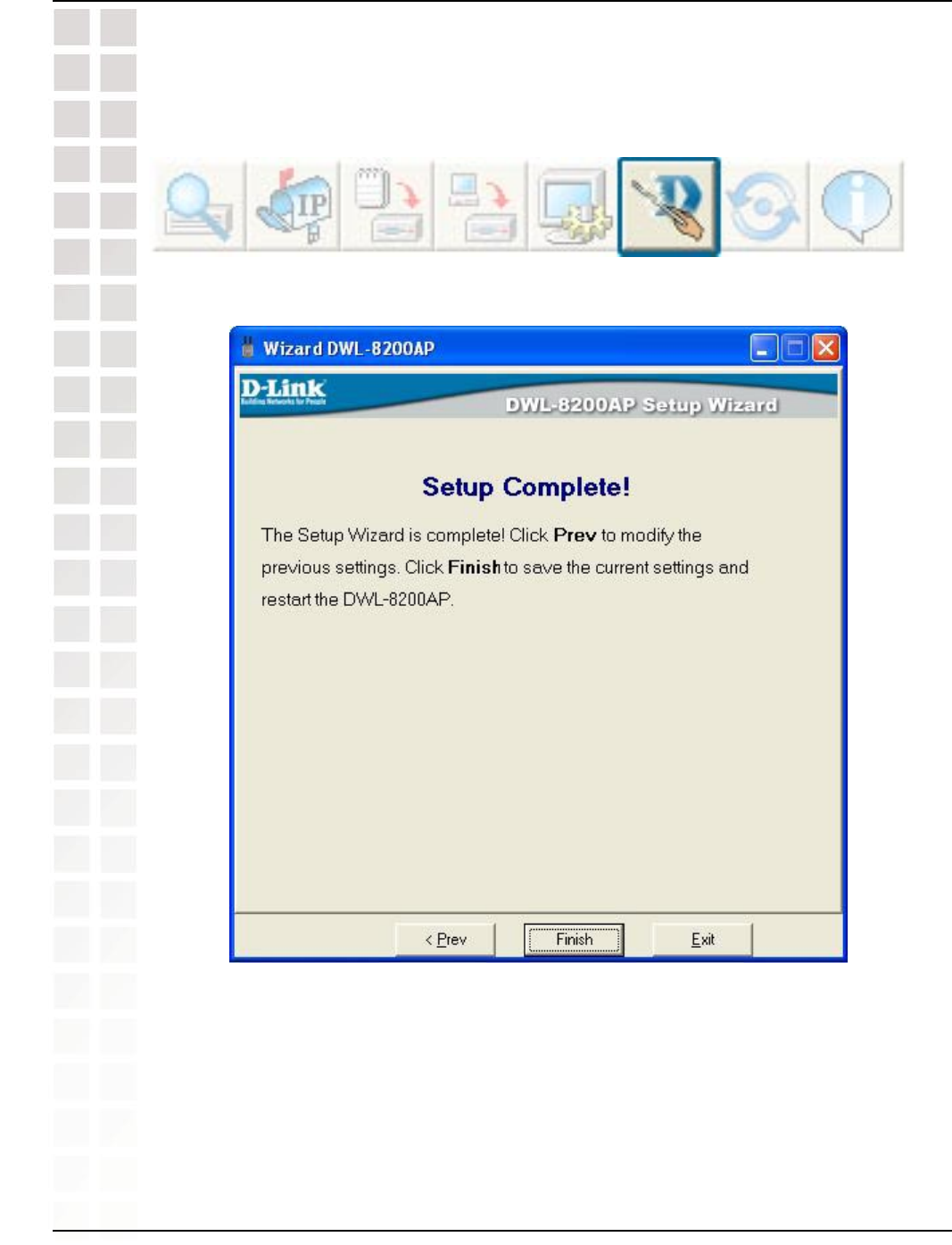
98
DWL-8200AP User’s Manual
D-Link Systems, Inc.
Using the AP Manager
Setup Wizard (continued)
The DWL-8200AP setup is complete!
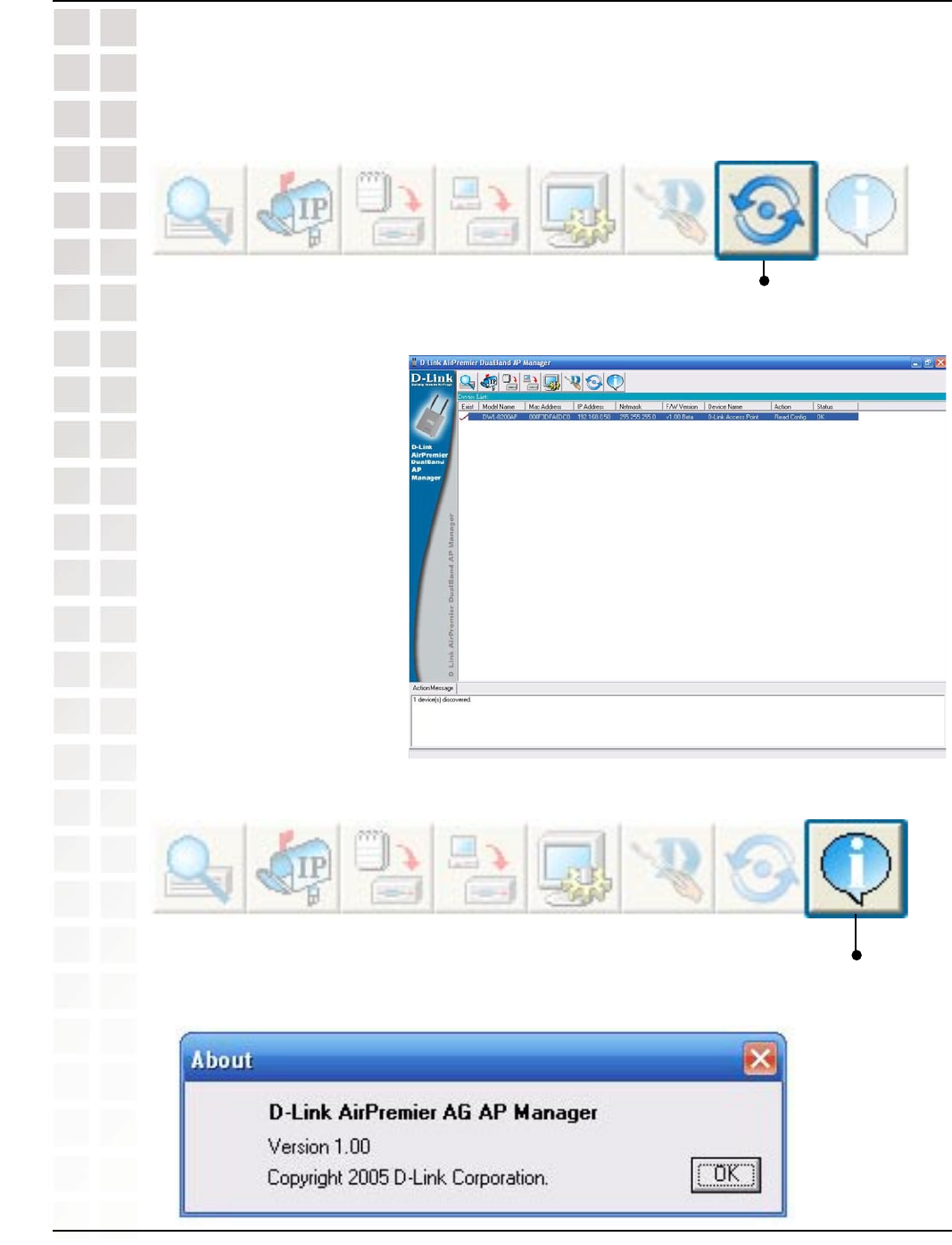
99
DWL-8200AP User’s Manual
D-Link Systems, Inc.
Using the AP Manager
Refresh
Click on this button to refresh the list of
devices available on the network.
Devices with a checkmark
next to them are still
available on the network.
Devices with an X are no
longer available on the
network.
Click on this button to view the
version of AP Manager.
About